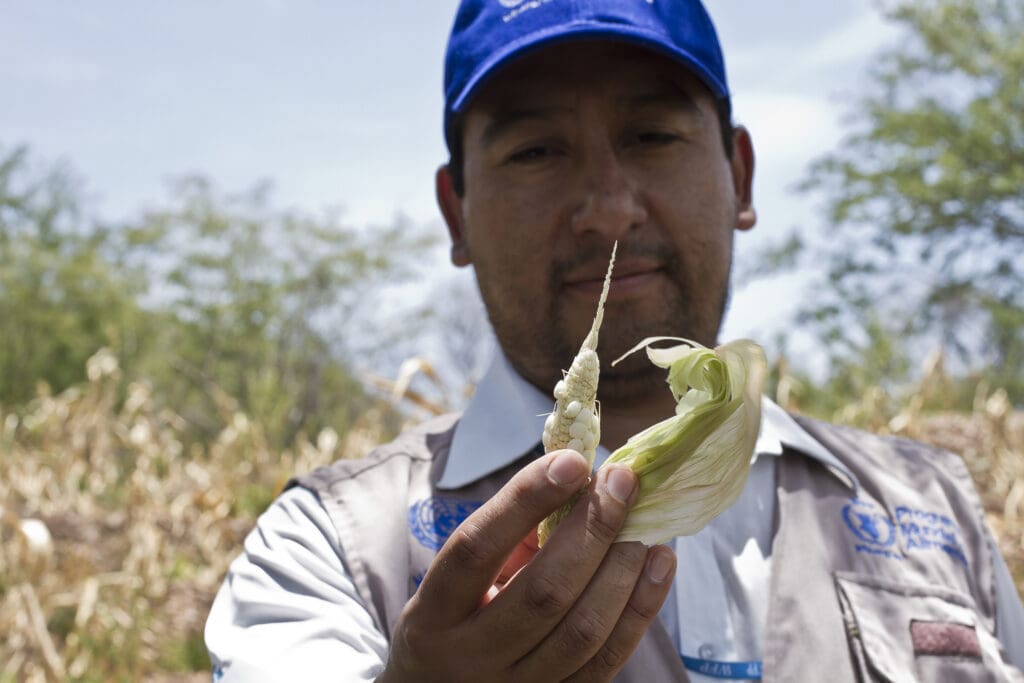Erratic Weather Patterns in the Central American Dry Corridor Leave 1.4 Million People in Urgent Need of Food Assistance

April 25th, 2019, Panama City | The United Nations Food and Agriculture Organization (FAO) and the World Food Programme (WFP) today warned that prolonged droughts and heavy rain have destroyed more than half of the corn and bean crops of the subsistence farmers along the Central American Dry Corridor, leaving them without food reserves and affecting their food security.
2.2 million people in El Salvador, Guatemala, Honduras and Nicaragua have lost their crops due to rainfall and drought; 1.4 million urgently need food assistance. FAO and WFP are requesting $72 million from the international community to provide food assistance to more than 700,000 people in the Dry Corridor.
Central American governments estimated that 2.2 million people have suffered crop losses, mainly due to the drought. Emergency food security assessments carried out in the Dry Corridor by WFP, FAO and the governments during the last quarter of 2018 validated these findings and confirmed that 1.4 million people out of the 2.2 million urgently need food assistance.
For 2019, FAO and WFP are requesting $72 million from the international community to provide food assistance to more than 700,000 people in the Dry Corridor.
These funds will also help to create and restore productive assets, diversify the subsistence farmers’ source of income, establish social protection safety nets and strengthen the farmers’ resilience in the face of future climate-related events.
“Subsistence farmers have started planting this month, many of them do not have food reserves and risk losing their crops again,” warned Miguel Barreto, WFP Regional Director for Latin America and the Caribbean. “If we don’t support them now, the coming lean season could be extremely hard for them, especially for children who are the most vulnerable, and whose nutritional condition could worsen as a result.”
Central American governments reported that in 2018, a delayed start to the rainy season in the Dry Corridor ruined up to 70 percent of the subsistence farmers’ first harvest, while in contrast too much rainfall damaged up to 50 percent of the second harvest.
In mid-February 2019, the United States National Oceanic and Atmospheric Administration (NOAA) announced the appearance of El Niño phenomenon and forecast that it would last until October. There is a high probability that El Niño will affect the sowing of staple grains during the first crop cycle, which will worsen the already fragile nutritional and food security of communities along the Dry Corridor.
FAO and WFP recommend subsistence farmers are informed about the current situation to prevent the loss of their crops due to a delayed rainy season. Alternatives for them to consider are replacing the existing water-dependant crops with sorghum and tubers, which need less water, or sowing short-cycle crops with the first rains in the dryer zones.
“We have to improve the resilience of people living in the Dry Corridor. Reinforcing monitoring and early warning systems, and mitigating the impact of droughts and rains through agricultural best practices, increases the families’ resilience and adaptation to strengthen their livelihoods, thus preventing that climatic events compromise their food security and force them to migrate,” said Adoniram Sanches, FAO Regional Coordinator for Mesoamerica and Representative in Panama.
Approximately half of the 1.9 million basic grain small producers in Central America live in the Dry Corridor. These families are subsistence farmers, which means that they harvest and eat the food that they grow, mainly corn and beans. If they lose a crop, they will not have reserves to eat or sell to survive until the next harvest.
Once their food reserves have been depleted, families often resort to emergency coping strategies. According to FAO, WFP and the governments, up to 82 percent of the families have sold their farming tools and animals to purchase food. They even skip meals or eat less nutritious foods.
More than 25 percent of the households surveyed do not have enough income to cover their basic food needs and eight percent of the families reported that they plan to migrate in response to this situation.
According to FAO and WFP, only by revitalizing the Dry Corridor can we create the conditions for communities to improve their way of life without having to leave their homes and undertake dangerous journeys in search of better opportunities.
About the World Food Programme | The United Nations World Food Programme saves lives in emergencies and changes the lives of millions of people through sustainable development. WFP works in more than 80 countries around the world, feeding populations affected by conflicts and disasters, and laying the foundations for a better future. @WFP_ES www.es.wfp.org
About the Food and Agriculture Organization of the United Nations | FAO has been working for more than 70 years to end hunger in the world. Its objective is to achieve food security for all and guarantee them regular access to sufficient and good quality food to lead an active and healthy life. With more than 194 member states, FAO works in more than 130 countries. @FAOAmericas www.fao.org/americas




